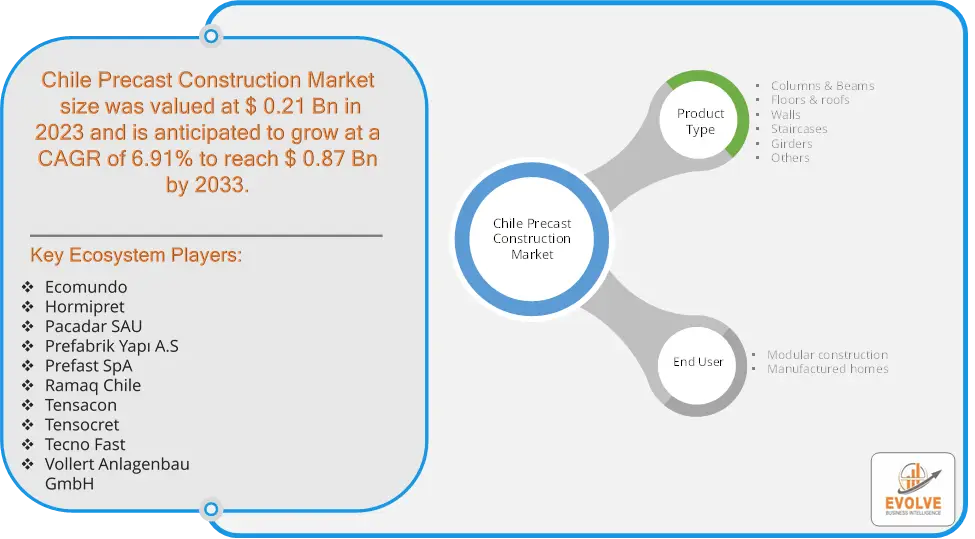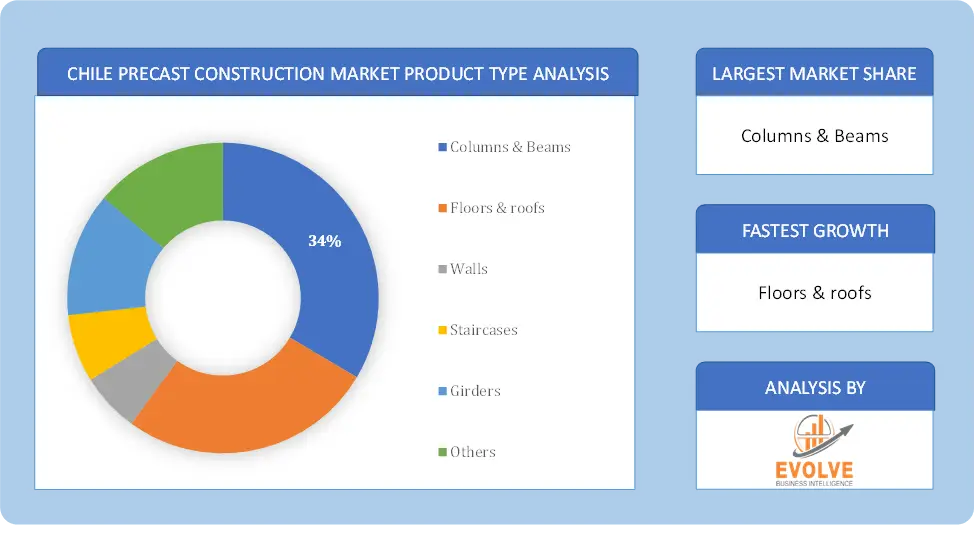Price range: $ 1,390.00 through $ 5,520.00
Chile Precast Construction Market Research Report: Information By Product Type (Columns & Beams, Floors & roofs, Walls, Staircases, Girders, Others), By End User (Modular construction, Manufactured homes), and by Region — Forecast till 2033
Page: 180
Description
Chile Precast Construction Market Overview
The Chile Precast Construction Market Size is expected to reach USD 0.87 Billion by 2033. The Chile Precast Construction Market industry size accounted for USD 0.21 Billion in 2023 and is expected to expand at a compound annual growth rate (CAGR) of 6.91% from 2023 to 2033. The Chile Precast Construction Market refers to the industry within Chile that involves the manufacturing and use of precast concrete components in construction projects. Precast construction involves producing concrete elements like beams, columns, panels, walls, and floors in a controlled factory environment and then transporting these components to construction sites for assembly.
The Chile Precast Construction Market is expected to grow due to increasing infrastructure development and a shift towards modern construction techniques that emphasize sustainability and efficiency.
Global Chile Precast Construction Market Synopsis
 Chile Precast Construction Market Dynamics
Chile Precast Construction Market Dynamics
The major factors that have impacted the growth of Chile Precast Construction Market are as follows:
Drivers:
Ø Technological Advancements
The integration of BIM and other digital construction technologies is facilitating the design, planning, and execution of precast construction projects, making them more attractive to developers looking for precision and efficiency. Advances in the design and manufacture of precast elements, including the use of new materials and construction techniques, are enhancing the versatility and appeal of precast construction in Chile. The reduction in on-site labour requirements due to the off-site manufacturing of precast components helps in controlling construction costs, which is a significant driver in a market sensitive to labor costs. The durability and low maintenance requirements of precast concrete make it a cost-effective choice over the lifecycle of a building, which is an attractive proposition for developers and owners.
Restraint:
- Perception of High Initial Investment Costs and Logistical Challenges
Establishing precast manufacturing facilities requires significant upfront investment in machinery, molds, and other infrastructure. This high initial cost can be a barrier for smaller construction firms or new market entrants. While precast components can reduce on-site labor costs, the transportation and installation of these heavy elements can be expensive, particularly for projects located in remote or difficult-to-access areas. The size and weight of precast components make transportation a logistical challenge, particularly in regions with poor infrastructure. This can lead to increased costs and delays, reducing the overall appeal of precast construction.
Opportunity:
⮚ Growing demand for Sustainable Construction Demand
With growing environmental awareness, there is an increasing demand for buildings that meet green building certifications such as LEED. Precast concrete’s energy efficiency, reduced waste production, and potential for incorporating recycled materials make it a strong candidate for sustainable construction projects. As Chile works towards its carbon reduction commitments, the demand for sustainable building materials will rise. Precast construction, which can be more energy-efficient and produce less waste than traditional methods, is well-positioned to capitalize on this trend.
Chile Precast Construction Market Segment Overview
By Product Type
 Based on Product Type, the market is segmented based on Columns & Beams, Floors & roofs, Walls, Staircases, Girders and Others. The Floors & roofs segment dominant the market. The use of precast products in floor and roof systems ensures even load distribution, making them ideal for developing gymnasiums, mills, garages, and commercial establishments such as hotels, manufacturing units, and education institutes. Precast components have thermal mass properties that reduce overheating within a room and subsequently reduce the carbon emissions of a building.
Based on Product Type, the market is segmented based on Columns & Beams, Floors & roofs, Walls, Staircases, Girders and Others. The Floors & roofs segment dominant the market. The use of precast products in floor and roof systems ensures even load distribution, making them ideal for developing gymnasiums, mills, garages, and commercial establishments such as hotels, manufacturing units, and education institutes. Precast components have thermal mass properties that reduce overheating within a room and subsequently reduce the carbon emissions of a building.
By End User
Based on End Users, the market segment has been divided into Modular construction and Manufactured homes. The Modular construction segment dominant the market. Due to the flexibility in design and ease of building structures. Modular homes are constructed with different modules manufactured off-site and assembled on permanent foundations.
Competitive Landscape
The Chile Precast Construction Market is highly competitive, with numerous players offering a wide range of software solutions. The competitive landscape is characterized by the presence of established companies, as well as emerging startups and niche players. To increase their market position and attract a wide consumer base, the businesses are employing various strategies, such as product launches, and strategic alliances.
Prominent Players:
- Ecomundo
- Hormipret
- Pacadar SAU
- Prefabrik Yapı A.S
- Prefast SpA
- Ramaq Chile
- Tensacon
- Tensocret
- Tecno Fast
- Vollert Anlagenbau GmbH
Scope of the Report
Global Chile Precast Construction Market, by Product Type
- Columns & Beams
- Floors & roofs
- Walls
- Staircases
- Girders
- Others
Global Chile Precast Construction Market, by End User
- Modular construction
- Manufactured homes
Global Chile Precast Construction Market, by Region
- North America
- US
- Canada
- Mexico
- Europe
- UK
- Germany
- France
- Italy
- Spain
- Benelux
- Nordic
- Rest of Europe
- Asia Pacific
- China
- Japan
- South Korea
- Indonesia
- Austalia
- Malaysia
- India
- Rest of Asia Pacific
- South America
- Brazil
- Argentina
- Rest of South America
- Middle East & Africa
- Saudi Arabia
- UAE
- Egypt
- South Africa
- Rest of Middle East & Africa
| Parameters | Indicators |
|---|---|
| Market Size | 2033: $0.87 Billion |
| CAGR | 6.91% CAGR (2023-2033) |
| Base year | 2022 |
| Forecast Period | 2023-2033 |
| Historical Data | 2021 |
| Report Coverage | Revenue Forecast, Competitive Landscape, Growth Factors, and Trends |
| Key Segmentations | Product Type, End User |
| Geographies Covered | North America, Europe, Asia-Pacific, Latin America, Middle East, Africa |
| Key Vendors | Ecomundo, Hormipret, Pacadar SAU, Prefabrik Yapı A.S, Prefast SpA, Ramaq Chile, Tensacon, Tensocret, Tecno Fast and Vollert Anlagenbau GmbH |
| Key Market Opportunities | • The growing demand for Sustainable Construction Demand |
| Key Market Drivers | • Technological Advancements • Cost Considerations |
REPORT CONTENT BRIEF:
- High-level analysis of the current and future Chile Precast Construction Market trends and opportunities
- Detailed analysis of current market drivers, restraining factors, and opportunities in the future
- Chile Precast Construction Market historical market size for the year 2021, and forecast from 2023 to 2033
- Chile Precast Construction Market share analysis at each product level
- Competitor analysis with detailed insight into its product segment, Government & Defense strength, and strategies adopted.
- Identifies key strategies adopted including product launches and developments, mergers and acquisitions, joint ventures, collaborations, and partnerships as well as funding taken and investment done, among others.
- To identify and understand the various factors involved in the global Chile Precast Construction Market affected by the pandemic
- To provide a detailed insight into the major companies operating in the market. The profiling will include the Government & Defense health of the company’s past 2-3 years with segmental and regional revenue breakup, product offering, recent developments, SWOT analysis, and key strategies.
Frequently Asked Questions (FAQ)
What is the growth rate of the global Chile Precast Construction Market?
The global Chile Precast Construction Market is growing at a CAGR of 0.87% over the next 10 years
Which region has the highest growth rate in the market of Chile Precast Construction Market?
Asia Pacific is expected to register the highest CAGR during 2023-2033
Which region has the largest share of the global Chile Precast Construction Market?
North America holds the largest share in 2022
Who are the key players in the global Chile Precast Construction Market?
Ecomundo, Hormipret, Pacadar SAU, Prefabrik Yapı A.S, Prefast SpA, Ramaq Chile, Tensacon, Tensocret, Tecno Fast and Vollert Anlagenbau GmbH are the major companies operating in the market.
Do you offer Post Sale Support?
Yes, we offer 16 hours of analyst support to solve the queries
Do you sell particular sections of a report?
Yes, we provide regional as well as country-level reports. Other than this we also provide a sectional report. Please get in contact with our sales representatives.
Additional information
| Packages | Single User License, Enterprise License, Data Pack Excel |
|---|
Table of Content
[html_block id="8037"]

